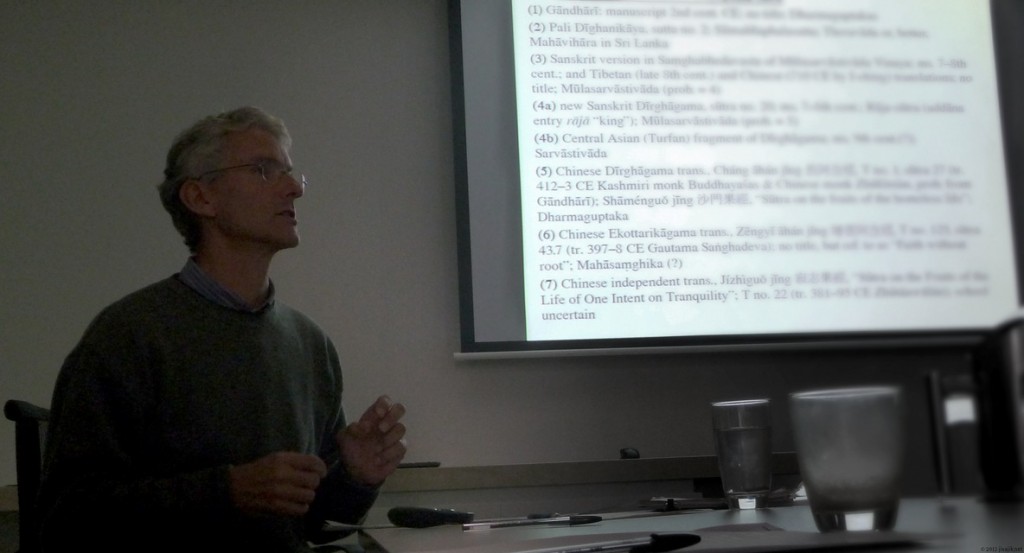Ronald M. Davidson. 2017. ‘Magicians, Sorcerers and Witches: Considering Pretantric, Non-sectarian Sources of Tantric Practices’. Religions (Special issue: Society for Tantric Studies 2016 Proceedings, eds. Glen A. Hayes & Sthaneshwar Timalsina), 8(9), 188 [33 pp.]. doi:10.3390/rel8090188 [PDF 🔓]
Eltschinger (2017), Why did Buddhists adopt Sanskrit?
Vincent Eltschinger. 2017. ‘Why did the Buddhists adopt Sanskrit?’ Open Linguistics 3 (Topical Issue on Historical Sociolinguistic Philology, ed. by Chiara Barbati and Christian
Gastgeber), pp.308–326. doi:10.1515/opli-2017-0015 [PDF 🔓]
Schlosser (2016), On the Bodhisattva Path in Gandhāra
Schlosser, Andrea. 2013 [2016]. “On the Bodhisattva Path in Gandhāra. Edition of Fragment 4 and 11 from the Bajaur Collection of Kharoṣṭhī Manuscripts”. Freien Universität Berlin: PhD diss. 313+iv pp. URN: urn:nbn:de:kobv:188-fudissthesis000000101376-1 [PDF]
From the Abstract: This dissertation contains an edition, translation and study of two unparalleled Buddhist texts from ‘Greater Gandhāra’ (eastern Afghanistan and northwestern Pakistan), written in the Gāndhārī language and Kharoṣṭhī script and dating from the first or second century CE.
Karashima, ‘Was the Aṣṭasāhasrikā composed in Gāndhārī?’ (2013)
Seishi Karashima. ‘Was the Aṣṭasāhasrikā Prajñāpāramitā Compiled in Gandhāra in Gāndhārī?’ Annual Report of the International Research Institute for Advanced Buddhology (ARIRIAB) at Soka University for the Academic Year 2012, vol.XVI, 2013, pp.171–188. [PDF]
This is a remarkable piece of detective work and a milestone in the study of the Mahāyāna, whether or not one thinks (as I do) that Prof. Karashima’s theory nails it. Karashima’s many years of lexicographical toil seem to have finally paid off: the earliest Chinese phonetic transcriptions from the Aṣṭasāhasrikā agree most fully with the newly found Gāndhārī fragments (for which see also Strauch 2007). And that, moreover, is merely one of many compelling indicators pointing to the composition of the text in Gandhāra.
One minor comment: the image of Dharmodgata discovering the Prajñāpāramitā written on gold plates vilīnena vaidūryeṇa — in “melted” lapis, according to Karashima (p.181) — sounds excessively fantastic. The reference is to lapis lazuli pigment, well known to medievalists as ultramarine, ‘beyond the sea’ — i.e., from Afghanistan.
Allon, ‘A Gāndhārī Śrāmaṇyaphala-sūtra’ (2013-04-05)
Mark Allon. ‘A Gāndhārī version of the Buddha’s Discourse on the Fruits of Living the Ascetic Life (Śrāmaṇyaphala-sūtra)’. Australasian Association of Buddhist Studies Victoria Seminar, 5th April 2013, Deakin Prime Campus, Melbourne.
Abstract
The Senior collection of Gandhāran Buddhist manuscripts includes a scroll which contains a Gāndhārī version of the introductory section of the Śrāmaṇyaphala-sūtra, the Buddha’s discourse to King Ajātaśatru on the benefits of living the ascetic or holy life. The appearance of a Gāndhārī version of this interesting and popular sūtra coincides with the appearance of a second Sanskrit witness of it, namely, that included in the new Dīrghāgama manuscript, which preliminary research indicates is similar to but not identical with the Sanskrit version found among the Gilgit manuscripts. We therefore now have Indic versions of the Śrāmaṇyaphala-sūtra in Gāndhārī (albeit incomplete), Pali, and Sanskrit, a Tibetan translation and four Chinese translations, which belong to a diversity of schools and originate from different times and places. Not surprisingly the Gāndhārī sūtra is not identical to any other version, but shows a complex relationship with them. In this paper I will discuss the Gāndhārī version of the sūtra and its relationship to the parallels in other languages, the possible reasons for its popularity, and the likely reasons for its inclusion in the Senior collection.


